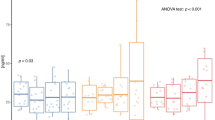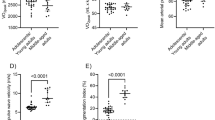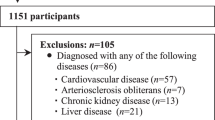Abstract
The accumulation of intramyocellular lipid (IMCL) and extramyocellular lipid (EMCL) is associated with arterial stiffness in middle-aged and older adults. Habitual aerobic exercise induces the improvement of arterial stiffness with reduction in fat accumulation. However, the relationship between aerobic exercise-induced changes in muscular lipids and arterial stiffness remains unclear. The purpose of this study was to investigate whether habitual aerobic exercise-induced changes in IMCL and EMCL content would lead to an improvement of arterial stiffness. First, in a cross-sectional study, we investigated whether cardiorespiratory fitness level affects the association between IMCL or EMCL content and arterial stiffness in 60 middle-aged and older subjects (61.0±1.3 years). Second, in an intervention study, we examined whether aerobic exercise training-induced changes in IMCL and EMCL content are associated with a reduction in arterial stiffness in 18 middle-aged and older subjects (67.0±1.7 years). In the cross-sectional study, IMCL content was negatively correlated with brachial-ankle pulse wave velocity (baPWV) (r=−0.47, P<0.05), whereas EMCL content was positively correlated with baPWV (r=0.48, P<0.05) in the low-fitness group, but was not correlated in the high-fitness group. Furthermore, 8-week aerobic exercise training in older adults increased IMCL content and reduced EMCL content. The training-induced change in baPWV was negatively correlated with training-induced changes in IMCL but was positively correlated with training-induced changes in EMCL. These findings suggest that aerobic exercise training-induced changes in IMCL and EMCL content may be related to a reduction in arterial stiffness in middle-aged and older adults.
This is a preview of subscription content, access via your institution
Access options
Subscribe to this journal
Receive 12 digital issues and online access to articles
$119.00 per year
only $9.92 per issue
Buy this article
- Purchase on Springer Link
- Instant access to full article PDF
Prices may be subject to local taxes which are calculated during checkout

Similar content being viewed by others
References
Hubert HB, Feinleib M, McNamara PM, Castelli WP . Obesity as an independent risk factor for cardiovascular disease: a 26-year follow-up of participants in the Framingham Heart Study. Circulation 1983; 67: 968–977.
Miyaki A, Maeda S, Choi Y, Akazawa N, Eto M, Tanaka K et al. Association of plasma pentraxin 3 with arterial stiffness in overweight and obese individuals. Am J Hypertens 2013; 26: 1250–1255.
Wildman RP, Mackey RH, Bostom A, Thompson T, Sutton-Tyrrell K . Measures of obesity are associated with vascular stiffness in young and older adults. Hypertension 2003; 42: 468–473.
Fox CS, Massaro JM, Hoffmann U, Pou KM, Maurovich-Horvat P, Liu CY et al. Abdominal visceral and subcutaneous adipose tissue compartments: association with metabolic risk factors in the Framingham Heart Study. Circulation 2007; 116: 39–48.
Choi TY, Ahmadi N, Sourayanezhad S, Zeb I, Budoff MJ . Relation of vascular stiffness with epicardial and pericardial adipose tissues, and coronary atherosclerosis. Atherosclerosis 2013; 229: 118–123.
Soliman EZ, Ding J, Hsu FC, Carr JJ, Polak JF, Goff DC Jr . Association between carotid intima-media thickness and pericardial fat in the Multi-Ethnic Study of Atherosclerosis (MESA). J Stroke Cerebrovasc Dis 2010; 19: 58–65.
Chen JY, Chou CH, Tsai WC, Wang MC, Ho CS, Li YH et al. Effects of increased systemic inflammation and central obesity on arterial stiffness in patients with nonalcoholic fatty liver disease. J Am Soc Hypertens 2012; 6: 253–260.
Liu J, Fox CS, Hickson D, Bidulescu A, Carr JJ, Taylor HA . Fatty liver, abdominal visceral fat, and cardiometabolic risk factors: the Jackson Heart Study. Arterioscler Thromb Vasc Biol 2011; 31: 2715–2722.
Hasegawa N, Kurihara T, Sato K, Homma T, Fujie S, Fujita S et al. Intramyocellular and extramyocellular lipids are associated with arterial atiffness. Am J Hypertens 2015; 28: 1473–1479.
Lim S, Meigs JB . Ectopic fat and cardiometabolic and vascular risk. Int J Cardiol 2013; 169: 166–176.
Després JP, Lemieux I . Abdominal obesity and metabolic syndrome. Nature 2006; 444: 881–887.
Miyaki A, Maeda S, Yoshizawa M, Misono M, Saito Y, Sasai H et al. Effect of habitual aerobic exercise on body weight and arterial function in overweight and obese men. Am J Cardiol 2009; 104: 823–828.
Kakiyama T, Sugawara J, Murakami H, Maeda S, Kuno S, Matsuda M . Effects of short-term endurance training on aortic distensibility in young males. Med Sci Sports Exerc 2005; 37: 267–271.
Ashor AW, Lara J, Siervo M, Celis-Morales C, Mathers JC . Effects of exercise modalities on arterial stiffness and wave reflection: a systematic review and meta-analysis of randomized controlled trials. PLoS ONE 2014; 9: e110034.
Thamer C, Machann J, Bachmann O, Haap M, Dahl D, Wietek B et al. Intramyocellular lipids: anthropometric determinants and relationships with maximal aerobic capacity and insulin sensitivity. J Clin Endocrinol Metab 2003; 88: 1785–1791.
Pruchnic R, Katsiaras A, He J, Kelley DE, Winters C, Goodpaster BH . Exercise training increases intramyocellular lipid and oxidative capacity in older adults. Am J Physiol Endocrinol Metab 2004; 287: E857–E862.
Sinha R, Dufour S, Petersen KF, LeBon V, Enoksson S, Ma YZ et al. Assessment of skeletal muscle triglyceride content by (1)H nuclear magnetic resonance spectroscopy in lean and obese adolescents: relationships to insulin sensitivity, total body fat, and central adiposity. Diabetes 2002; 51: 1022–1027.
Hattori M, Nakagawa Y, Harada K, Bando M, Okano G . Characteristics of intramyocellular lipid content in skeletal muscles of overweight men and endurance-trained athletes. Jpn J Phys Fitness Sports Med 2006; 55: S43–S48.
Fujie S, Sato K, Miyamoto-Mikami E, Hasegawa N, Fujita S, Sanada K et al. Reduction of arterial stiffness by exercise training is associated with increasing plasma apelin level in middle-aged and older adults. PLoS ONE 2014; 9: e93545.
Miyachi M, Tanaka H, Yamamoto K, Yoshioka A, Takahashi K, Onodera S . Effects of one-legged endurance training on femoral arterial and venous size in healthy humans. J Appl Physiol 2001; 90: 2439–2444.
Tanaka H, Monahan KD, Seals DR . Age-predicted maximal heart rate revisited. J Am Coll Cardiol 2001; 37: 153–156.
Provencher SW . Automatic quantitation of localized in vivo 1H spectra with LCModel. NMR Biomed 2001; 14: 260–264.
Weis J, Johansson L, Ortiz-Nieto F, Ahlström H . Assessment of lipids in skeletal muscle by LCModel and AMARES. J Magn Reson Imaging 2009; 30: 1124–1129.
Iemitsu M, Maeda S, Otsuki T, Sugawara J, Tanabe T, Jesmin S et al. Polymorphism in endothelin-related genes limits exercise-induced decreases in arterial stiffness in older subjects. Hypertension 2006; 47: 928–936.
Kobayashi S, Honda S, Murakami K, Sasaki S, Okubo H, Hirota N et al. Both comprehensive and brief self-administered diet history questionnaires satisfactorily rank nutrient intakes in Japanese adults. J Epidemiol 2012; 22: 151–159.
Yudkin JS, Stehouwer CD, Emeis JJ, Coppack SW . C-reactive protein in healthy subjects: associations with obesity, insulin resistance, and endothelial dysfunction: a potential role for cytokines originating from adipose tissue? Arterioscler Thromb Vasc Biol 1999; 19: 972–978.
Okamoto Y, Arita Y, Nishida M, Muraguchi M, Ouchi N, Takahashi M et al. An adipocyte-derived plasma protein, adiponectin, adheres to injured vascular walls. Horm Metab Res 2000; 32: 47–50.
Eriksson P, Van Harmelen V, Hoffstedt J, Lundquist P, Vidal H, Stemme V et al. Regional variation in plasminogen activator inhibitor-1 expression in adipose tissue from obese individuals. Thromb Haemost 2000; 83: 545–548.
Motoshima H, Wu X, Sinha MK, Hardy VE, Rosato EL, Barbot DJ et al. Differential regulation of adiponectin secretion from cultured human omental and subcutaneous adipocytes: effects of insulin and rosiglitazone. J Clin Endocrinol Metab 2002; 87: 5662–5667.
Orshal JM, Khalil RA . Gender, sex hormones, and vascular tone. Am J Physiol Regul Integr Comp Physiol 2004; 286: R233–R249.
Oosthuyse T, Bosch AN . Oestrogen's regulation of fat metabolism during exercise and gender specific effects. Curr Opin Pharmacol 2012; 12: 363–371.
Goodpaster BH, He J, Watkins S, Kelley DE . Skeletal muscle lipid content and insulin resistance: evidence for a paradox in endurance-trained athletes. J Clin Endocrinol Metab 2001; 86: 5755–5761.
Schenk S, Horowitz JF . Acute exercise increases triglyceride synthesis in skeletal muscle and prevents fatty acid-induced insulin resistance. J Clin Invest 2007; 117: 1690–1698.
Corpeleijn E, Saris WH, Blaak EE . Metabolic flexibility in the development of insulin resistance and type 2 diabetes: effects of lifestyle. Obes Rev 2009; 10: 178–193.
Liu L, Zhang Y, Chen N, Shi X, Tsang B, Yu YH . Upregulation of myocellular DGAT1 augments triglyceride synthesis in skeletal muscle and protects against fat-induced insulin resistance. J Clin Invest 2007; 117: 1679–1689.
da Silva VZ, Lima AC, Vargas FT, Cahalin LP, Arena R, Cipriano G Jr . Association between physical activity measurements and key parameters of cardiopulmonary exercise testing in patients with heart failure. J Card Fail 2013; 19: 635–640.
Cao ZB, Miyatake N, Higuchi M, Miyachi M, Tabata I . Predicting VO(2max) with an objectively measured physical activity in Japanese men. Eur J Appl Physiol 2010; 109: 465–472.
Dipietro L, Caspersen CJ, Ostfeld AM, Nadel ER . A survey for assessing physical activity among older adults. Med Sci Sports Exerc 1993; 25: 628–642.
Acknowledgements
This work was supported by Grants-in-Aid for Scientific Research from the Ministry of Education, Culture, Sports, Science and Technology of Japan (KAKENHI: #26282199 for MI).
Author information
Authors and Affiliations
Corresponding author
Ethics declarations
Competing interests
The authors declare no conflict of interest.
Rights and permissions
About this article
Cite this article
Hasegawa, N., Fujie, S., Kurihara, T. et al. Effects of habitual aerobic exercise on the relationship between intramyocellular or extramyocellular lipid content and arterial stiffness. J Hum Hypertens 30, 606–612 (2016). https://doi.org/10.1038/jhh.2016.28
Received:
Revised:
Accepted:
Published:
Issue Date:
DOI: https://doi.org/10.1038/jhh.2016.28
This article is cited by
-
Effects of Different Long-Term Exercise Modalities on Tissue Stiffness
Sports Medicine - Open (2022)



